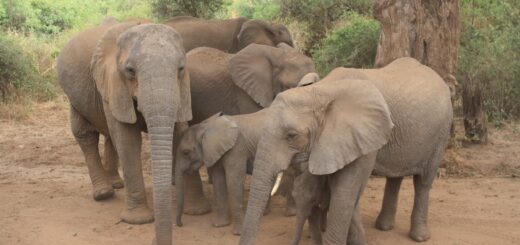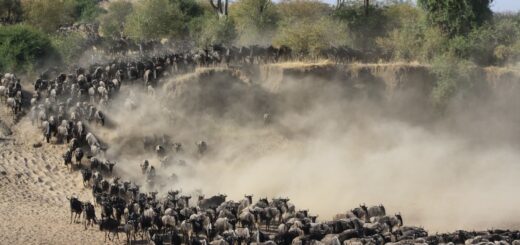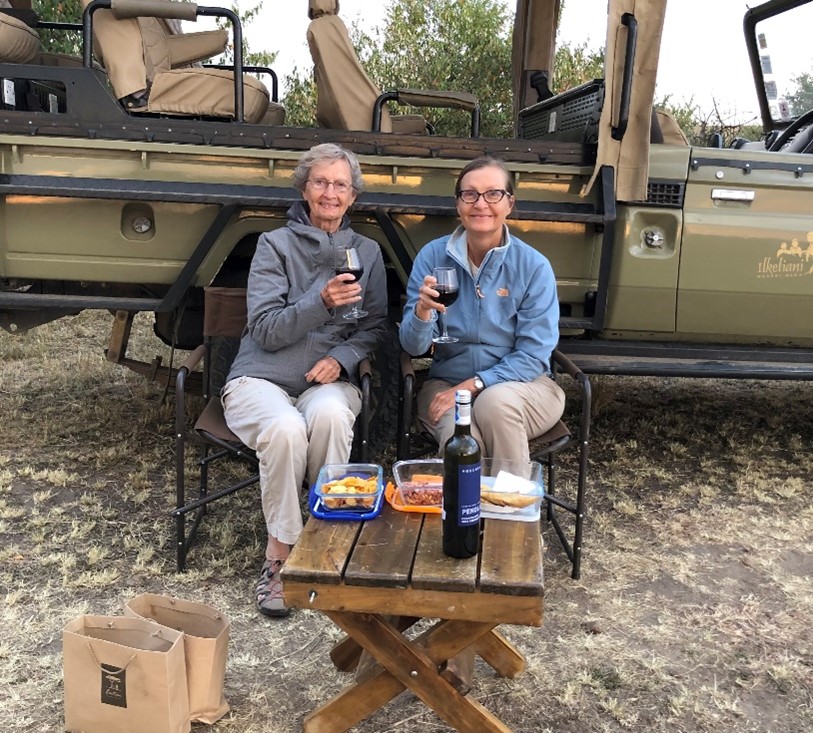Ngorongoro Crater
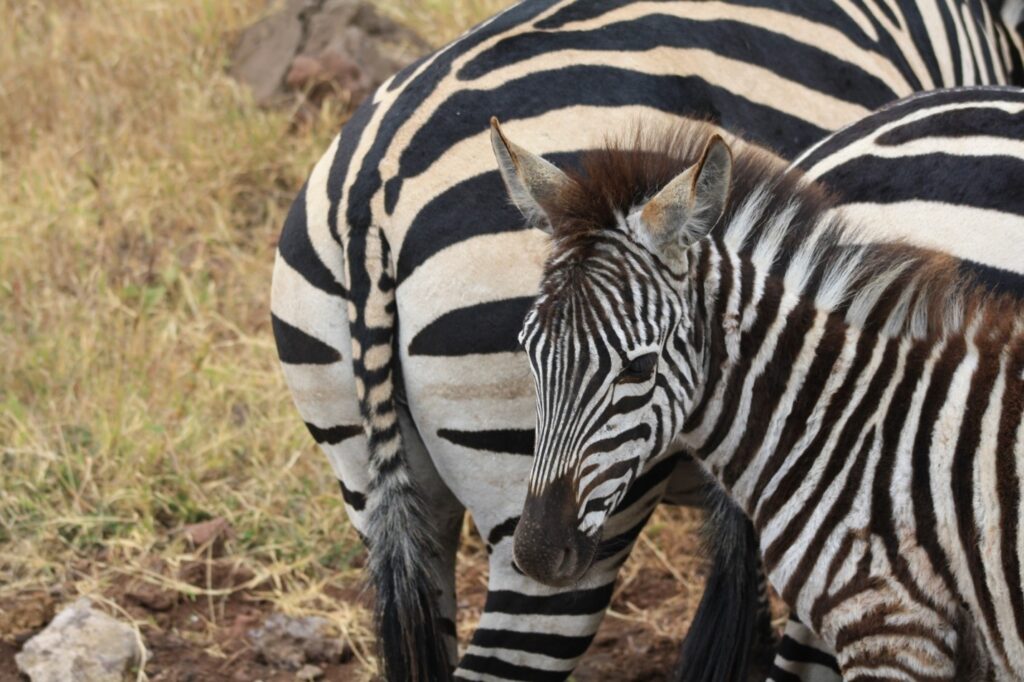
Travel Advice for Seniors: Ngorongoro Crater
Our second trip to Africa, we were laser-focused on the Wildebeest Migration and flew into Kilimanjaro, Tanzania to begin our three-week adventure! Africa is one of those places that we could go back to time and time again. In fact, right after we boarded the plane to go back to the US on our first trip to Botswana, we both looked at each other and said at the same time, “How soon until we can come back?”.
We went with a private tour on this safari holiday, but our actual game drives were typically with a max of six people, usually just with another couple. For most of our safaris, the vehicles were Land Rovers and most times we had a roof or at least a canvas topper. We didn’t have any problem with the other safari riders, everyone was there to enjoy the show!
A word on safaris…the adage “In the Land Rover out of the food chain, out of the Land Rover into the food chain” does indeed apply. The guides are NOT kidding when they give you instructions. Also, wear comfortable clothing as you will be doing a lot of sitting, waiting and watching. We brought a lightweight carry bag of camera equipment, water, suntan lotion, etc. You will want to bring a camera capable of telephoto shots and live action shots.
It is interesting that the animals tend to view the Land Rovers as a large object such as a rock and don’t pay any attention to them. As usual and annoying as it may be to see six to eight safari vehicles surrounding popular sights such as the riverbanks during the migration, lion sightings and especially the rare rhino spotting, they don’t bother the wild animals. Also, usually the drivers know when to back off and give the animal an exit and a lot of times will take turns with the best viewing areas.

Also, you will need to tip your individual guides. We asked on the first day whether we would have the same guide/driver for our entire time or if we would be switching up. The guides depend on the tips, and we tipped on the last day. Also, note that the hotels or camps should be tipped and there is usually a common tip jar in the lobby area. You can use your own judgement on what is appropriate to tip, most of the time the tour company recommended amounts are very high but consider what type of service you are expecting and be prepared to shuck out extra individual tips if you ask for a private event or special treatment.
With the Serengeti our ultimate destination, and after spending some time in Kilimanjaro, we headed for the famous Ngorongoro crater which was on the way. The crater is about 10–12 miles across and covers 102 square miles. It also hosts the “Big 5”, rhinos, African buffalo, lions, elephants and leopard, though the rhinos were not on view the two days that we toured.
We stayed at the Farm House Valley, which was full board with drinks extra. We stayed in a room away from the main dining room and went to the communal area to dine daily. It was a nice accommodation and very close to the Crater, so it was an easy early drive to get in before the crowd. They also made a nice birthday cake for Mom, which is not something that happens regularly, and everyone who worked there sang and banged pots and pans and danced around here to sing a song of celebration. It was really a wonderful evening! Of course, we tipped appropriately.
A word on accommodation….the closer you can stay to the park or event the better. That way you can beat the Daytrippers coming in for the day and it is less crowded at least for a while. Most of the parks we visited had a moderate number of other vehicles and we didn’t feel like it was too crowded.
Also note that there is an entry fee to the parks/reserves, and it can be quite expensive. To make the best of your time you will need to get up before dawn and take lunch with you unless you are staying in the park. If you are staying in the park, you can go back to the camp for lunch and go back out for dusk and sundowners (happy hour by the watering hole!). Also, while getting up before dawn may be annoying, the animals are most active at dusk and dawn so that is the best time to see them. You are on their schedule after all!
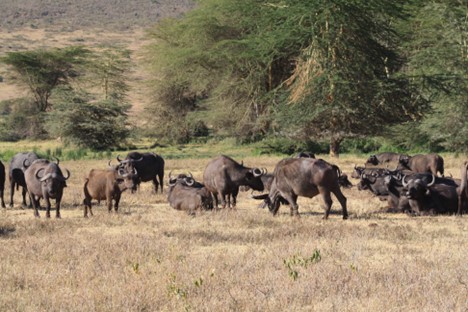
We went out for full day safaris with lunch brought along for two days at Ngorongoro. One day may be enough to see the sights but we wanted a chance to see the famous endangered black rhinos which may or may not be out on the days we are driving.
In this part of Africa, rhinos are carefully guarded animals. Poaching is very common so while the guides may know where the best place to see them may be, they may not be out of the brush on the day you are there. There are more rhinos in South Africa, but it is possible to see them in Tanzania. Unfortunately, we didn’t see any at Ngorongoro crater, though there was a small group there.
We did see an enormous amount of wildlife and there were several lake areas featuring colorful birds and hippos. There are well-worn tracks that vehicles are required to stay on, and the animals use the tracks too, so it is possible to get some nice close up shots. The animals are used to vehicles and don’t get spooked.
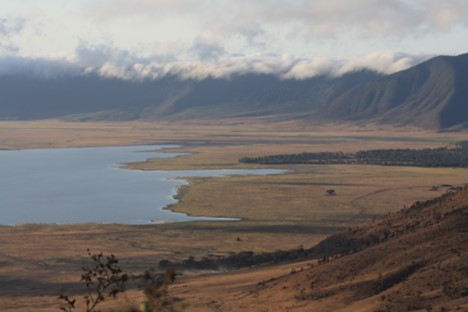
The crater for all intents and purposes is its own ecosystem. It is 2000 feet deep with a steep ramped entry into/out of it. About 2-3 million years ago, it was originally a large volcano that erupted and collapsed in on itself. Some animals don’t really leave the crater and some such as zebras and wildebeest will migrate in and out with the seasons. We did see some elephants on top of the crater rim, but no other animals at the top.
We saw plenty of lions, buffalos, elephants, wildebeests, black spotted hyenas, elands, zebras, gazelles and a few leopards. There is a great deal of wildlife in the crater compared to most parks.
We were happy to have spent two days in the crater, but it was time to move on to the wide-open spaces of the Serengeti and to the Great Wildebeest Migration!
Where we stayed: Farm House Valley. Meals included, drinks extra. Very nice hotel and close to the crater. Accessibility assistance available upon request.
How we got there: 3-4 Hour drive from Arusha..This was part of a three-week private tour through Tanzania, Kenya and South Africa.
General Accessibility Information: See notes above. Tanzania is generally not considered very handicapped accessible, with limited wheelchair accessibility in most places. Some tour operators offer accessible tours, and some high-end hotels are accessible.Call in advance to verify and make specialty arrangements.See our sections on specialty apps and accessible travel for more on accessibility assistance.


